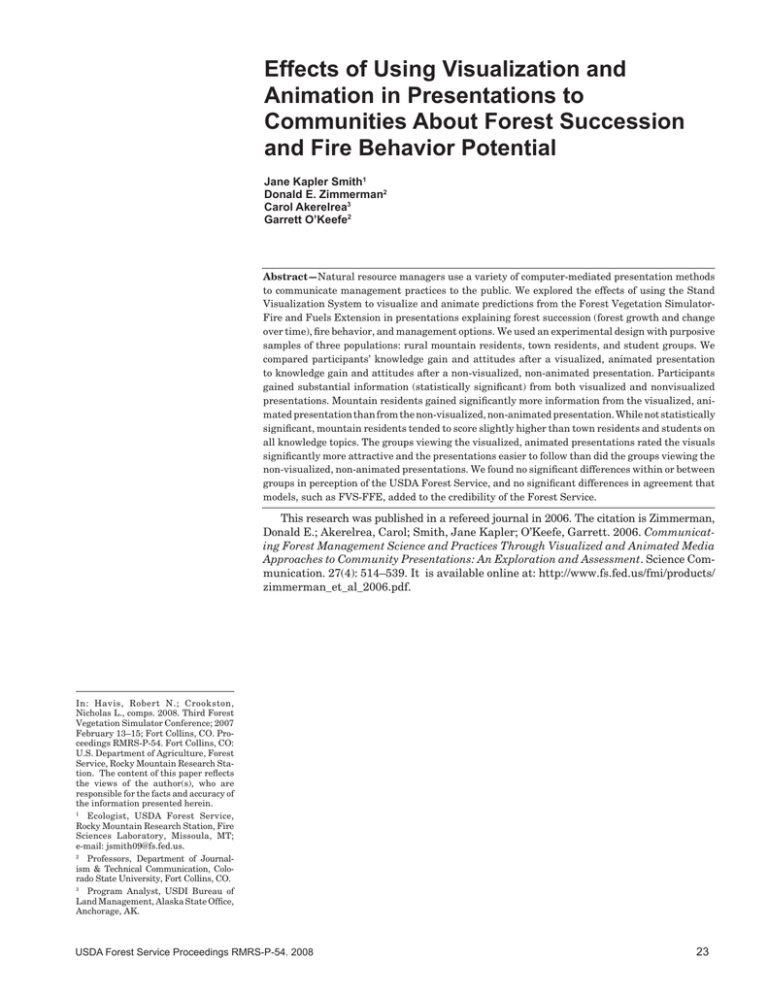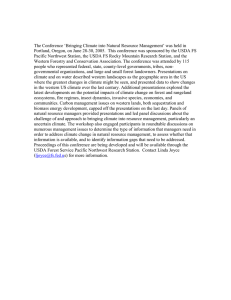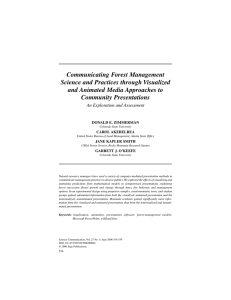Effects of Using Visualization and Animation in Presentations to
advertisement

Effects of Using Visualization and Animation in Presentations to Communities About Forest Succession and Fire Behavior Potential Jane Kapler Smith1 Donald E. Zimmerman2 Carol Akerelrea3 Garrett O’Keefe2 Abstract—Natural resource managers use a variety of computer-mediated presentation methods to communicate management practices to the public. We explored the effects of using the Stand Visualization System to visualize and animate predictions from the Forest Vegetation SimulatorFire and Fuels Extension in presentations explaining forest succession (forest growth and change over time), fire behavior, and management options. We used an experimental design with purposive samples of three populations: rural mountain residents, town residents, and student groups. We compared participants’ knowledge gain and attitudes after a visualized, animated presentation to knowledge gain and attitudes after a non-visualized, non-animated presentation. Participants gained substantial information (statistically significant) from both visualized and nonvisualized presentations. Mountain residents gained significantly more information from the visualized, animated presentation than from the non-visualized, non-animated presentation. While not statistically significant, mountain residents tended to score slightly higher than town residents and students on all knowledge topics. The groups viewing the visualized, animated presentations rated the visuals significantly more attractive and the presentations easier to follow than did the groups viewing the non-visualized, non-animated presentations. We found no significant differences within or between groups in perception of the USDA Forest Service, and no significant differences in agreement that models, such as FVS-FFE, added to the credibility of the Forest Service. This research was published in a refereed journal in 2006. The citation is Zimmerman, Donald E.; Akerelrea, Carol; Smith, Jane Kapler; O’Keefe, Garrett. 2006. Communicating Forest Management Science and Practices Through Visualized and Animated Media Approaches to Community Presentations: An Exploration and Assessment. Science Communication. 27(4): 514–539. It is available online at: http://www.fs.fed.us/fmi/products/ zimmerman_et_al_2006.pdf. In: Havis, Robert N.; Crookston, Nicholas L., comps. 2008. Third Forest Vegetation Simulator Conference; 2007 February 13–15; Fort Collins, CO. Proceedings RMRS-P-54. Fort Collins, CO: U.S. Department of Agriculture, Forest Service, Rocky Mountain Research Station. The content of this paper reflects the views of the author(s), who are responsible for the facts and accuracy of the information presented herein. 1 Ecologist, USDA Forest Service, Rocky Mountain Research Station, Fire Sciences Laboratory, Missoula, MT; e-mail: jsmith09@fs.fed.us. 2 Professors, Department of Journalism & Technical Communication, Colorado State University, Fort Collins, CO. 3 Program Analyst, USDI Bureau of Land Management, Alaska State Office, Anchorage, AK. USDA Forest Service Proceedings RMRS-P-54. 2008 23

